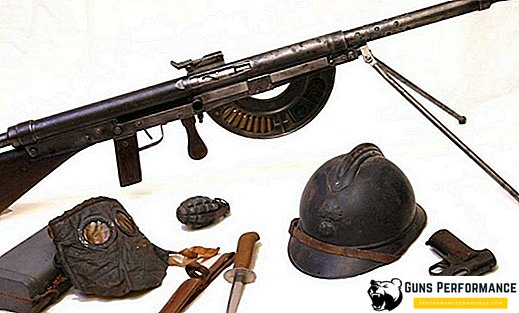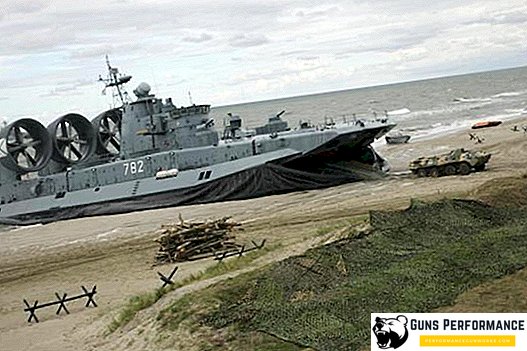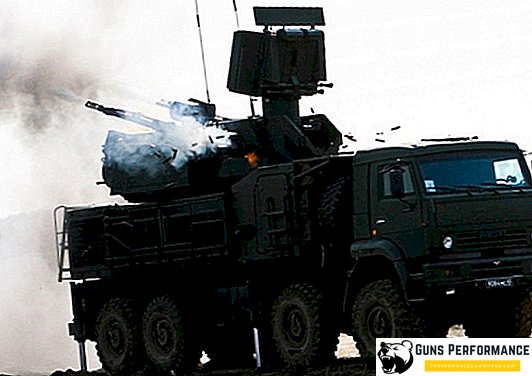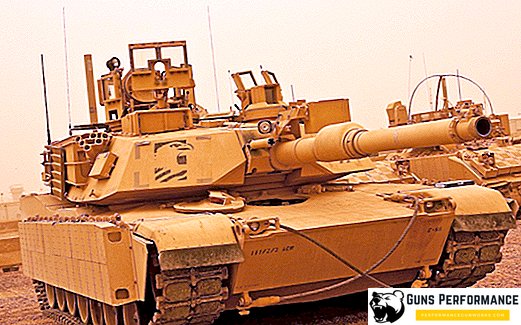For a Russian person, any talk about choosing a weapon for hunting a bear leads to the emergence of the first thought and the first association, namely - hunting with a spear. In reality, in the mentality of the Russian people, the bear and the cattle are inseparable from each other. It is known that this type of weapon was used for a long time on the territory of Russia, even in those times when firearms had already become a daily occurrence.
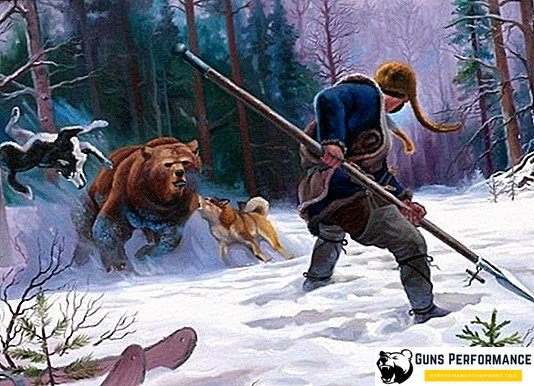
Bear fishing with spear
Even in our days, a rat in talking about fishing for a bear has not receded into the background. Among the majority of ancient pole arms, the spear can be called the only long-lived woman, and even more so in our state. The prototype of the croats is, perhaps, the most ancient types of weapons - spears.
One should not detract from the values of this seemingly primitive pole weapon, although in part it is so. Not always this "primitive" remained unchanged in its configuration and purpose. It, like other offensive weapons, has been modified, improved and adapted to certain tactics of application based on the resulting transformations in the art of hand-to-hand combat or hunting.
Moreover, spears throughout their entire historical life also changed social statuses. They were both the most primitive weapons in the hands of commoners, and the symbolic instrument of power over the whole world. The simplest spears gave life to more than one variety of military or hunting weapons. As in their time from primitive pointed stakes, they themselves arose.
Undoubtedly, spears were used mainly as piercing weapons. Initially, they were with long and narrow tips. The difference was only along the length of the shafts, which was explained by their use by an infantryman or rider. Nevertheless, little by little, with the modification of the tactics of combat, the modified spears themselves were used in a new way.

The main hunting weapon in the Middle Ages on a large and dangerous beast is, of course, pole-arms. Based on the types of weapons, and developed tactics of hunting. Animals were hunted with the help of dogs, trying to drive them into a trap, where they finished off. In such circumstances, the main roles were assigned to hunting swords, daggers and, of course, spears.
Step by step, the spears began to be singled out to a special hunting variety, which differed from similar types of military weapons. Proceeding from the appointment, hunting spears began to be called bear or boar. They had their own very specific features. So, they were made extremely durable to withstand the mass of animals affected. Such animals were mostly bears or harps with an average weight of more than 150 kg.
The edge of the spear also deserves attention. The tips were wide, leafy, with extremely sharpened edges. The shafts were strong and had no less than two meters in length. In the presence of strength and dexterity, they were a formidable weapon.
The spears were struck in the hearts or necks of the animals. As a rule, for such powerful animals as bears and boars, the very first blows were fatal. The feathers of the spears produced not only severe wounds, but crushed the bones with vertebrae. The key to success for the hunters of that time was not only the ability to deliver deadly blows, but also for some time to hold back the rearing powerful animals.

Spears should not slide off in the hands and at the same time not penetrate deeply into the heavy carcasses of enraged wild animals. They had to be ready for re-strikes. To do this, the crossbar began to be placed on the bushings of the tips, but more often pieces of horns were hung up. Such cross-pieces did not allow spears to penetrate into the carcasses of animals beyond the sleeves of feathers.
To keep the shafts rough and not slipping in the hands (even soaked in blood), they were almost completely wrapped with narrow leather straps and nailed with nails. At times a plume of horsehair or animal fur was hung on these hunting spears under a feather. Such decorations also had practical assignments - they did not allow the poles to be soaked in blood. Someone, to facilitate hunting spears, made their tips hollow. Like any hunting weapon, wild boar and bear spears possessed elements of decor, including gilding.
In the XVI century, almost everywhere, there was a craze to decorate weapons, including hunting ones. Not only tips were decorated in spears, but also shafts. So, the engravings of that time possessed images of hunting scenes. Its members were holding bear and boar spears.
Strange shafts were sometimes depicted, either twisted, then knobby, or braided with leather. To obtain such a bumpy, rough and at the same time patterned surface of the shaft, a special technology was used. The trunks of living trees were cut in places, and even freed from the bark. Further, the right patterns were applied on their surfaces with the help of a knife, and then everything was covered with bark.
After a while, incisions were raised. When the living trunks reached the desired configurations and sizes, and something like blistering, nodules and patterns arose on them, the trees were cut down and scrupulously dried. These "naturally decorated" shafts were sometimes brought to amazing beauty.
Horned bears for a bear by Russian hunters
To begin with, it should be noted that, although the weapon is called a spear, these are not forks, which are often portrayed as ignorant illustrators of books. It is not excluded that the word "cattle" came from the horn, which was tied with the tip of the cattle and was the diameter.
Vladimir Dahl, in his Explanatory Dictionary, describes a spear as a handgun, from a spear, long beards, wide two-bladed knives on a pole. With such a weapon went only to the bear. Cross-pieces were attached to the shafts under the spears, which the bears themselves seized when they climbed a spear. As a matter of fact, the cattle was described in the same way as the bear spear already mentioned.
It is believed that the Russian hunting ratchet descended from military weapons of the same name, which was used from ancient times by ancient Russian knights. It was described by the well-known weapon expert and historian Pavel Pavlovich von Winkler, something like this: "The rogatins (riggers) were weapons similar to spears, but with wide, flat and sharp feathers on both sides, which in this type of weapon were actually called spears."
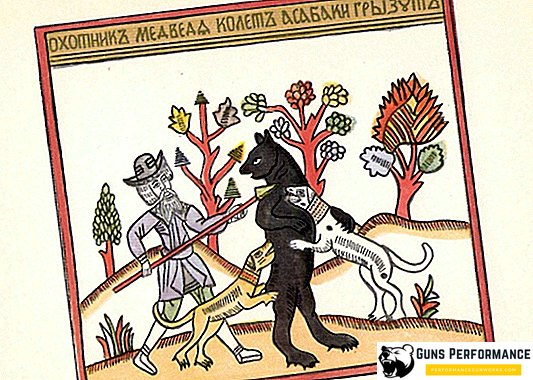
There were apples under the roars, and under them were Tulei, impaled on the poles, or in-house. To the warriors better to hold on to their weapons, two or three bitches of metal were attached to the farmlands. Rich people wrapped them with gold or silver laces, silk braid, etc.
A spear hunt was done in two ways:
- In the process of bear fishing in the den;
- When the animal is already raised, it is pursued with the help of dogs.
For the same reasons, there are two types of cattle:
- The first is more massive and difficult for berloznogo fishing;
- The second - lightweight for fishing trail.
Feathers of berlozh, weighted cattle reached a length of 35 cm, a width of 7 cm, a thickness of 1 cm. The rastische (shafts) reached a length of 176 cm. Consequently, the length of the whole rattan with a feather reached 21,100 mm. To facilitate the time, feathers were fitted on one channel from different sides. Rogatin for hunting followed the length of feathers 32 cm, width 6.5 cm, thickness 9 mm. Feathers of specks pass naturally into strong necks and further into tubes, which sit on strong shafts.
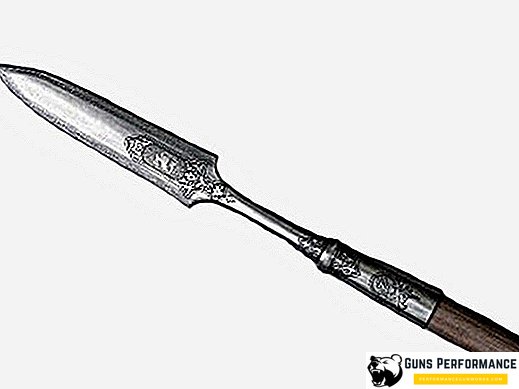
As a rule, rowan or bird cherry, felled in spring and dried, but not completely dried, served as the material for the shafts or ratiste. These shafts were not pricked, kept elastic and were very durable. The thickness of the shafts reached 4.5 cm. The ratovisches were mounted on the butt sides, before that they were smiled or soaked with the help of hot resin. Such catfishes served people on the hunt for centuries.




